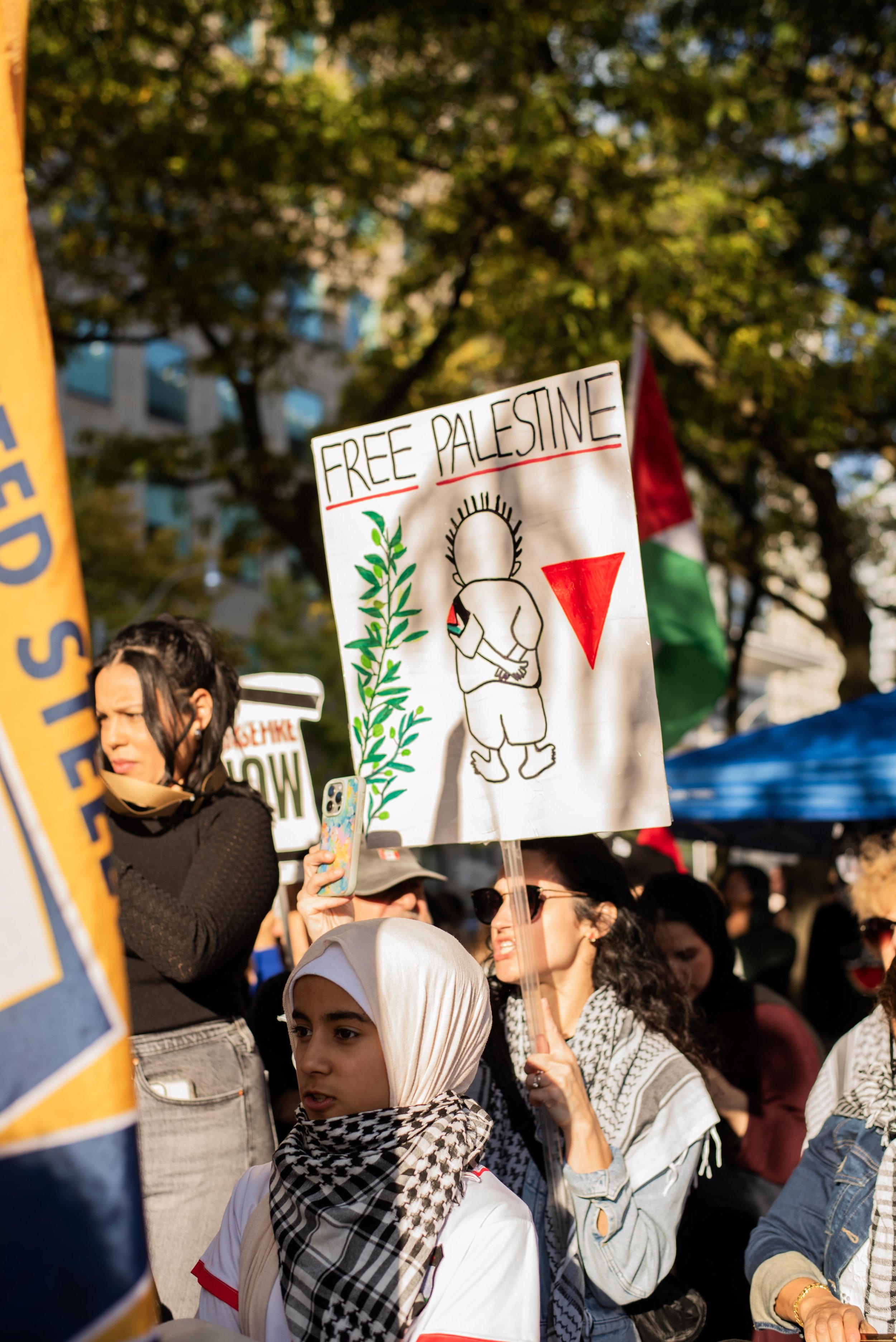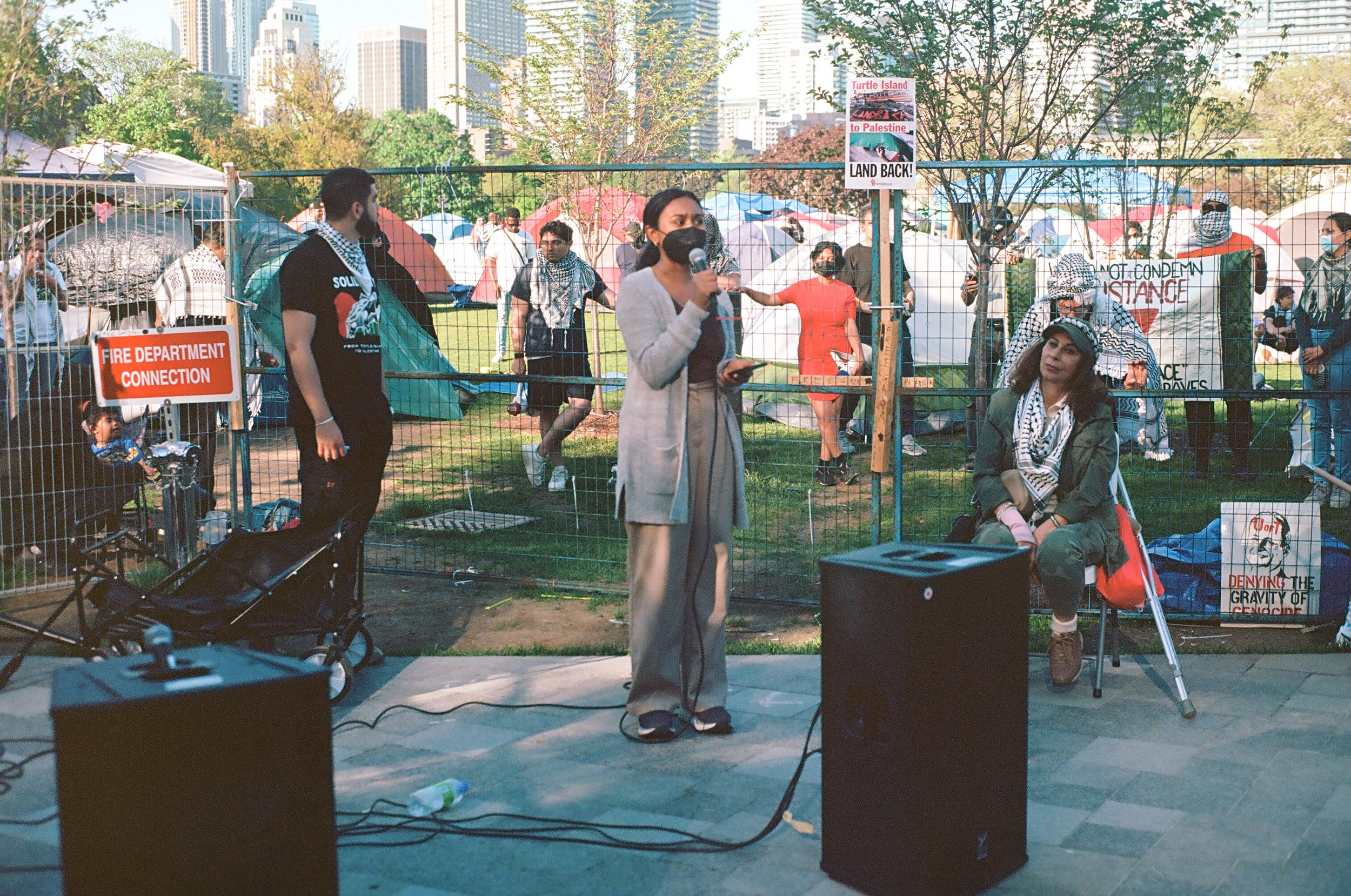
ISSUE 07 | FALL/WINTER 24/25
BEHIND THE LENS: PHOTO-JOURNALISM, CENSORSHIP, AND PALESTINE
By Asha Swann
Photographs by Shireen Khan
Reporters Without Borders has stated that Palestine is “the most dangerous country to be a journalist,” with over one hundred journalists killed within six months after the State of Israel declared war on October 7, 2023. By December 2023, UK-based publication The Guardian said the war is the deadliest conflict for journalists in over thirty years, with both reporters and photojournalists being targeted for providing media coverage of the atrocities.
Hundreds of journalists have been killed and even more have been displaced since Israel’s siege began in Gaza. According to data compiled by the Committee to Protect Journalists, the cause of death for around 75 percent of the journalists was Israeli airstrikes, Israeli snipers and IDF forces. By August 2024, 111 journalists killed were Palestinian, 2 were Israeli, and 3 were Lebanese.
There is an inherent danger that comes from being a journalist covering an armed conflict, despite having legal protection under international humanitarian law. A visible press vest and a reputable media organization don't guarantee safety: journalists from Reuters, Al-Jazeera, The Turkish Radio and Television Corporation, Agence France-Presse and more have all been killed. Even reporters working for Israeli media are under attack. Nir Hasson, a reporter for Haaretz — one of the largest print newspapers in Israel, founded in 1918 — was attacked after stepping in to stop a mob from beating Palestinian journalist Saif Kwasmi.
Photographs and videos coming from journalists in Palestine have been circulating on social media since October. These images more often than not depict violence, blood, tears, missing limbs, and rubble. Journalists in Canada have been criticized by both Palestinian groups and independent media organizations for not fairly covering the severity of the violence, as continuously documented by photojournalists and reporters in the region.
Shireen Khan, a Mississauga-based photojournalist, has been attending and photographing the Palestinian protests since February 2024. Shireen describes that the censorship that photojournalists like herself may face from covering protests in Canada can't be compared to the oppression that reporters in Palestine face.





“What is this? Are you scared of your account getting locked or something?” Shireen asked rhetorically. “I think it's cowardice to be like, ‘I have all these privileges, and I'm not going to risk them at all.’”
Shireen has been photographing social justice movements since 2018. Her main subject has been Palestinian protests. Since October 2023, she estimates she’s attended between 10-15 protests throughout the Greater Toronto Area, including the student encampment at the University of Toronto.
The Palestinian protests across Canada overwhelmingly have the same requests: a divestment from Israeli military weapons, ending the occupation of Israeli settlements in Gaza and the West Bank and an immediate ceasefire. The protests also aim to draw attention to the number of deaths caused by the military against Palestinian children, as demonstrated in data published by the Canadians for Justice and Peace in the Middle East (CJPME). Speeches from Palestinian refugees have been prominent at the protests, according to Shireen.
Shireen described often feeling shocked at the content she would hear during speeches, as people would describe the number of bombs being dropped by the Israeli military into the Gaza Strip.
“They said Israel's bombed more people than Hiroshima,” she described, explaining that some protesters came prepared with bar graphs and data about the bombings.
The statement that the Israeli bombing in Gaza has been more deadly than the United States dropping the atomic bomb on Hiroshima in Japan during World War II was first stated by third-party organization Euro-Med Human Rights Monitor (EMHRM) in November 2023, just one month after the war officially began. In the last year, the statement has gone viral.
The EMHRM, a Geneva-based human rights organization, released a statement saying the Israeli army has bombed “over 12,000 targets in the Gaza Strip, with a record tally of bombs exceeding 10 kilograms of explosives per individual.” Data shows that the Hiroshima bomb detonated with the equivalent of 15,000 tons of dynamite. The EMHRM cited Israeli War Minister Yoav Gallant as their source: Gallant has been documented declaring over 10,000 bombs have been dropped in Gaza, releasing 25,000 tons of explosives within the first two months of the war. Photos captured by freelance photographers living in the area have regularly documented the destruction, despite threats of censorship.
Journalists and photographers face huge amounts of censorship in Gaza, even on the rare occasions that the Israeli military allows them to pass through the checkpoints. Reporters Without Borders has highly criticized the overwhelming number of times journalists have been denied entry into Gaza at the Rafah crossing — the sole land connection between Gaza and the rest of the world. When journalists are banned, overhead satellite technology has shown continuous amounts of destruction, even in so-called safe zones. The technology used to document natural disasters from space is now being used to document the widespread rubble throughout the Gaza Strip, according to a report from CBC News.
Media censorship doesn’t just mean that journalists are barred from entering the occupied Palestinian territories. It also means that within the State of Israel, journalists are having more and more difficulties in reporting the government’s military siege.
Anat Saragusti, the press freedom director for the Union of Journalists in Israel, said in an interview with CBC News that this censorship predates the current war, but because Israeli journalists are denied entry into Gaza, news organizations struggle to accurately report on what’s happening in the region.
Censorship from the Israeli government to their own press has been documented since at least 1982, according to an archived New York Times story about journalists being required to submit content to censors. In 2018, independent Israeli publication +972 Magazine spoke out against the killing of journalists by the Israeli Defense Forces, demanding “international protection for journalists in Gaza.” The magazine had also previously reported that journalists can risk a prison sentence and backlash if they refuse to submit to the State’s censoring organization. The Jerusalem Post has also previously condemned the Israeli Defense Forces for purposely targeting reporters, citing international law. Israeli investigative journalist and documentary filmmaker Yuval Abraham is one of the more prominent Israeli reporters to face death threats after publicly calling for a ceasefire last February.
According to The Guardian, journalists in Gaza are increasingly receiving threats from the Israeli Defense Forces, with some reporters saying the Israeli military threatens the lives of their family members if they refuse to stop covering the violence. In the same article, The Guardian reported that while the State of Israel continues to deny deliberately targeting journalists, Israel’s ambassador to the UN tweeted out calling for the “elimination” of certain photographers.
While Shireen has had minor altercations with the police and some of her content removed from social media, she is aware of the privilege she holds as a photographer in Canada and the responsibility that comes with it.
“As long as this is still going on, I have to do my part … I want my pictures to be in a textbook one day. We can't let anyone forget that was ever going on. I don't know when it'll end, but it's got to be right now.”
Shireen’s final piece of advice for those looking to cover the protests is to focus on safety within the organizing community.
“Stick with the protesters,” she said. “Don’t have a hero complex … If you are going alone, stay with the group.”
Find more of Shireen’s photography on Instagram at @shireenkphotoz.


